The 1896 Paris-Marseilles
Leon Bollee registered the name voiturette for his little sporting tricar of 1895; but the term was so easily memorable that it soon became used for any light car. However, the first voiturette class to appear in motor racing was true to the term's origins, as it was composed entirely of Bollees. It happened in the 1896 Paris-Marseilles contest, in which class C was for any vehicle which was not a motor car nor a motor cycle - and this meant Bollees.
In any case, cylinder capacities of even the largest cars of the period were still quite modest - the Panhards racing in Paris-Marseilles had engines of only 1396 cc. There was little point in basing a voiturette class on swept volume. The 1897 Paris-Dieppe still had an all-Bollee voiturette class - and Jamin's Bollee shamed all the larger and theoretically more powerful vehicles by coming in first overall, averaging 25.2mph for the 106.2 mile race.
For the 1898 season, however, the first genuine attempt to separate the large cars from the small was made, again in the Paris-Marseilles, in which the Bollees were now relegated to the motorcycle category, and cars were divided into two categories, one for cars weighing over 400 kg, and cars weighing between 200-400 kg, with side-by-side seating for two people: thus 'the light vehicles were protected from the abnormal racing car.'
The 1899 Paris-St Malo
But there were only two entries in the class, a Georges Richard and a Parisienne, and their performance was so minimal that they could do no better than 21st and 23rd overall. The generic term 'voiturette' was first applied in the 1899 Paris-St Malo race; the same year the first race for this class of vehicle only was organised by Sport Unicersal Illustre from Paris to Rambouillet and back, and proved a triumph for
Louis Renault. Hitherto, the term 'voiturette' had been applied at the whim of race organisers: but at last in 1901 a firm classification was laid down. It remained in force for the next six years, and established a voiturette as a car weighing between 250-400 kg.
Voitures Legeres and Grandes Voitures
From 400-650 kg came voitures legeres, while grandes voitures weighed over 650 kg (and less than 1000 kg from 1902). It was first applied in the 1901 Paris-Bordeaux, in which the class was dominated by Renault cars of 8 hp, Louis Renault's class-winning car also coming twelfth in the overall results and proving faster than most of the more powerful voitures legeres. Renaults again headed the class result lists in the major race of 1901, the Paris-Berlin. Louis Renault's class-winning average of 36.9 mph for the 687 miles on his 1021cc single-cylinder Renault compared very favourably with the performance of the outright winner, Fournier, who averaged 44.1 mph on a Mors of 10,088cc and earned him eighth place overall, ahead of any of the voitures legeres.
Inevitably, as the manufacturers became more skilled at building lighter chassis, so the voiturettes, just like the larger cars, began to have larger and larger engines installed: in the Paris-Madrid of 1903, the winning Clement had an 18 hp four-cylinder engine of 2290 cc, and a competing Darracq was endowed with an even larger power unit, a 20 hp four of 3770cc. It was to eliminate such freakish machinery that the popular magazine l' Auto conceived a new voiturette formula in 1905, in which engine capacity was to be limited to 1 litre, weight was to be restricted, and cars were to be subjected to a six days trial before the event.
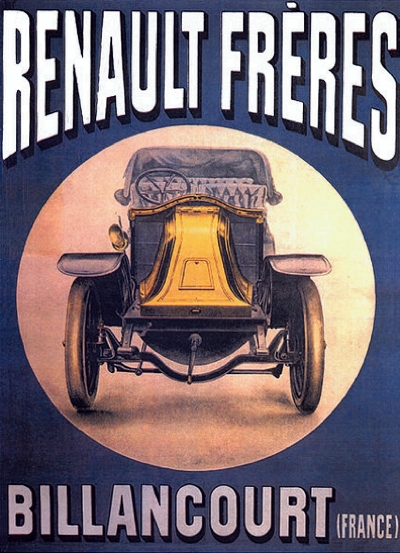
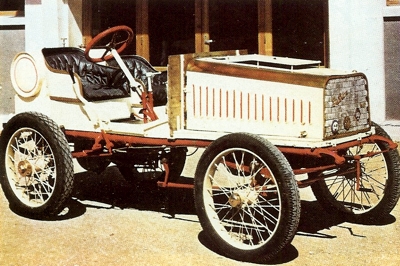 1902 De Dion-Bouton Voiturette.
1902 De Dion-Bouton Voiturette.
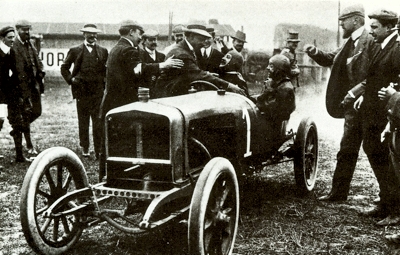 Delage Voiturette victory. This photo shows Guyot after winning the Grand Prix de Voiturettes at Dieppe in 1908.
Delage Voiturette victory. This photo shows Guyot after winning the Grand Prix de Voiturettes at Dieppe in 1908.
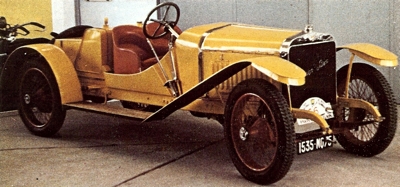 Hispano Suiza Sport Voiturette of 1912.
Hispano Suiza Sport Voiturette of 1912.
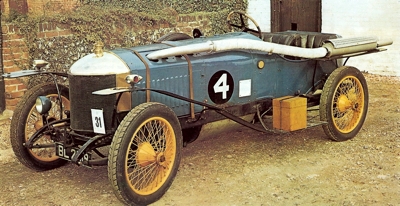 The victorious Delage 3 litre car from the 1911 Coupe de l'Auto. The Delage produced 50 bhp @ 3000 rpm.
The victorious Delage 3 litre car from the 1911 Coupe de l'Auto. The Delage produced 50 bhp @ 3000 rpm. |
The Coupe de l' Auto and the Sicilian Cup
Even though voiturette racing under the old regime had become almost non-existent, the new concept failed to reawaken interest in the class, and the 'Coupe de l'Auto', run off in November 1905, was a signal failure, with no overall winner - in fact the results were annulled.
Undaunted, I'Auto exercised that famous French talent for compromise and totally recast the regulations for 1906, imposing a bore restriction to 120 mm for single-cylinder engines and 90 mm for twins-fours were not admitted - and stipulating a minimum car weight of 700 kg. This formula succeeded where its predecessor had failed, and interest in the new voiturette class was greatly stimulated, to the extent that for 1907 there were two front-line voiturette races - the Coupe de l' Auto and the Sicilian Cup.
L' Auto once again altered the rules, reducing bore size to 100 mm for singles, 80 mm for twins, and setting a 670 kg weight limit for singles, 850 kg for twins. Both events were won by a marque exclusively associated with voiturettes, Sizaire-Naudin. M. Naudin won both races (his partner, Sizaire, had won the 1905 Coupe de I' Auto), while De Dion-Bouton and Lion-Peugoot were also strongly represented in the results.
There were four voiturette events in 1908, two in Italy (won by Guippone's Lion-Peugeot and two in France, the
Grand Prix des Voiturettes, won by Guyot's Delage, and the Coupe de L'Auto (which now admitted four-cylinder cars, restricting their bore size to 65 mm, and again imposed maximum weight limits, of 500 kg for singles, 600 kg for twins and 650 kg for fours).
Despite the changes, it was the 'old school' of voiturettes which dominated the results, with Naudin and Sizaire in the first two places, and Goux (Lion-Peugeot) third. As
Grand Prix racing was now, by official decree, moribund, the Coupe de L'Auto took on new importance in the motor racing calendar, and became the training ground for some of the great racing drivers, such as Georges Boillot. Moreover, it promoted the development of high-efficiency engines of moderate displacement, and unwittingly helped to pave the way for a new generation of
Grand Prix cars.
For 1909 there were yet more changes to the formula: all cars were limited to a weight of 600 kg, while single cylinder cars could have cylinder dimensions falling within the parameters 100mm x 250mm to 120mm x 124mm (1963cc - 1402cc); twins could have dimensions between 80mm x 192mm (1930cc) and 95mm x 98mm (1389cc); fours were restricted to dimensions between 65 mm x 150 mm (1991cc) and 75mm x 75mm (1325cc). In theory the new regulations were intended to assist the development of light four-cylinder power units: in practice, they encouraged the building of freakish long-stroke single-cylinder power units, which dominated the results lists.
Lion-Peugeot
Lion-Peugeots of cathedralesque appearance won all three main voiturette races of 1909, the Sicilian Cup and the Catalan Cup at Sitges falling to Goux, while his team mate Guippone took the Coupe de L'Auto itself. Fastest car in the Coupe race was Boillot's Lion-Peugeot, with cylinder proportions like a stove-pipe, and six valves-three inlet, three
exhaust -crammed into its cylinder-head.
The high, narrow and ugly Lion-Peugeots continued to dominate the 1910 results, with 'Boillot, Guippone and Goux coming in one-two-three in Sicily, and Goux and Boillot in the first two places at Sitges: but, significantly, multi-cylinder cars were now getting a look in, as third at Sitges was an Hispano-Suiza driven by Zuccarelli.
Even longer strokes were permissible that year, and Lion-Peugeot responded by fielding V4 racers with 65 mm x 260 mm engines (3451cc) which proved highly unstable, with fatal results for Guippone. However, these freakish machines were soundly trounced by Zuccarelli's 65 mm x 200 mm Hispano (2655cc), which finished first in the Coupe de l' Auto, followed by Goux's twin-cylinder Lion-Peugeot and Chasagne's Hispano.
Boillot's V4 Lion-Peugeot was fourth. During 1911-1913, the Coupe de l'Auto was once again the only front-line voiturette race, but now a maximum capacity of 3 litres was imposed, while bores and strokes had to fall within the ratios 1:1 to 2:1; in 1912, there was a minimum weight of 800 kg, in 1913 a maximum weight of 900 kg and a ban on forced induction.
Delage were victorious in 1911, while
Sunbeam came one-two-three in the 1912 Coupe de l'Auto, which earned them fourth-fifth-sixth places in the Grand Prix, which was run concurrently with the Coupe to ensure a good entry. Thus voiturettes were now able to defeat the racing monsters: and for 1914
Grand Prix cars had become virtual voiturettes, with a capacity limit of 4. 5 litres. The 1913 Coupe de l' Auto went to Peugeot, as did the Grand Prix: but voiturettes were now once again growing into full-size cars, and so 'Grand Prix' races for those most ephemeral of machines, the cyclecars, entered the racing calendar.
With the departure of the Coupe de l'Auto, the great days of voiturette racing were over. The series had proved a major catalyst in the development of the high-efficiency
internal combustion engine, and subsequent events bearing the name voiturette were not nearly as significant.
As formula changes lowered the cylinder capacity of the Formula One racing cars of the day, so the need for a voiturette class diminished, though the term survived throughout the 1920s and 1930s - the
ERA was just about the last car to bring any lustre to the term 'voiturette'. But with all its freaks and failures, it was the Coupe de l'Auto which had really supplied the stimulus to the designers and manufacturers-without it, engine development could well have lagged in that doldrum period when the
Grand Prix was in limbo.
Also see: Formula 1
Results |
World Land Speed Records 



